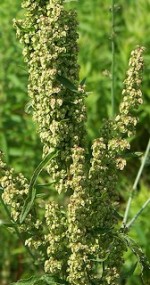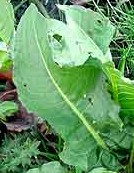 Although native to Europe and western Asia, curly dock is a perennial weed that has naturalized throughout North America and become invasive in some areas. It prefers rich, moist, heavy soils but can be found in many habitats including meadows, fields, waste areas, forest edges, lawns and gardens. It is not entirely without virtue, however, as flowering stems are beautiful in vase arrangements. The young leaves are edible and tasty although high in oxalic acid and can bring on urinary track problems and kidney stones.
Although native to Europe and western Asia, curly dock is a perennial weed that has naturalized throughout North America and become invasive in some areas. It prefers rich, moist, heavy soils but can be found in many habitats including meadows, fields, waste areas, forest edges, lawns and gardens. It is not entirely without virtue, however, as flowering stems are beautiful in vase arrangements. The young leaves are edible and tasty although high in oxalic acid and can bring on urinary track problems and kidney stones.

 Description: The plant starts out in the fall as a basal rosette of bluish-green leaves, 2-12” long, with wavy margins. The following spring a tall thick reddish stem emerges that may grow to five feet tall. Leaves are borne alternately on the stem and decrease in size as they near the top
Description: The plant starts out in the fall as a basal rosette of bluish-green leaves, 2-12” long, with wavy margins. The following spring a tall thick reddish stem emerges that may grow to five feet tall. Leaves are borne alternately on the stem and decrease in size as they near the top  and gradually take on a reddish-purple color as they mature. Small flowers are produced in clusters on the tips of the stems in early summer. The flowers are enclosed in green sepals that turn brown as they mature. The fruits are triangular, winged, and shiny brown to reddish brown when mature. About 40,000 seeds may be produced by a plant and the seeds can remain viable in the soil for over 50 years. A long, thick, yellow-orange tap root anchors the plant.
and gradually take on a reddish-purple color as they mature. Small flowers are produced in clusters on the tips of the stems in early summer. The flowers are enclosed in green sepals that turn brown as they mature. The fruits are triangular, winged, and shiny brown to reddish brown when mature. About 40,000 seeds may be produced by a plant and the seeds can remain viable in the soil for over 50 years. A long, thick, yellow-orange tap root anchors the plant.

 Control: Curly dock is best hand dug when small and young in the fall. Once the plant is established it is hard to eradicate because the long tap root is difficult to pull up and will resprout if any of it is left behind. To Removing the flowering stalks before they go to seed is important to prevent spread of the weed. Selective broadleaf herbicides are effective.
Control: Curly dock is best hand dug when small and young in the fall. Once the plant is established it is hard to eradicate because the long tap root is difficult to pull up and will resprout if any of it is left behind. To Removing the flowering stalks before they go to seed is important to prevent spread of the weed. Selective broadleaf herbicides are effective.